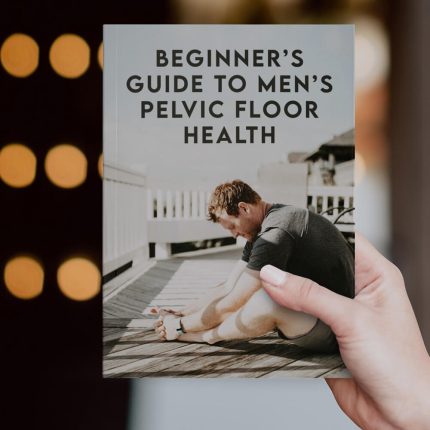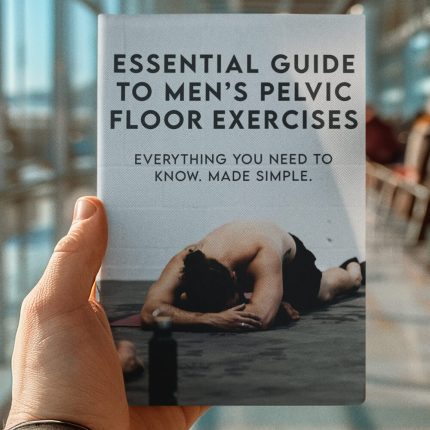
Pelvic Floor Therapy
Pelvic Floor Internal Examination Male

Ever thought about your pelvic floor as the unsung hero of your core and overall well-being? In the world of male health, the pelvic floor is not just a bunch of muscles doing a secret workout, it’s a powerhouse that supports your internal organs, contributes to your performance, and even influences your posture. Welcome to a deep dive into "Pelvic Floor Internal Examination Male", where we break down complex medical jargon with a dash of humor, a pinch of genuine advice, and a whole lot of practical insights tailored for Gen-Z and millennial men seeking to up their wellness game.
Quick Links to Useful Sections
- Understanding the Male Pelvic Floor: More Than Just Core Support
- Why Pelvic Floor Internal Examinations Matter for Men
- A Closer Look at the Pelvic Floor Internal Examination for Men
- Preparing for Your Pelvic Floor Internal Examination
- What to Expect During the Examination
- Understanding Your Pelvic Floor Assessment Results
- Pelvic Floor Exercises for Men: Strengthen Your Foundation
- Integrative and Holistic Approaches to Male Pelvic Floor Health
- Mindfulness and Meditation
- Yoga and Pilates
- Acupuncture and Massage
- Exploring Technology: Innovative Tools in Pelvic Floor Assessments
- Addressing Common Concerns and Debunking Myths
- Resources and Community Support: Your Next Steps
- Integrating Pelvic Floor Health Into Your Daily Life: Tips for Sustainable Wellness
- Your Personalized Path Forward: Building a Tailored Pelvic Floor Plan
- Step 1: Get a Comprehensive Assessment
- Step 2: Define Your Goals
- Step 3: Combine Therapeutic Modalities
- Step 4: Adopt a Consistent Routine
- Step 5: Regular Follow-Up and Adjustments
- Integrative and Holistic Approaches FAQs: Your Questions Answered
- Your Journey to Empowered Male Pelvic Health
Understanding the Male Pelvic Floor: More Than Just Core Support
When we talk about the male pelvic floor, we're referring to a group of muscles, ligaments, and connective tissues stretching from the pubic bone to the tailbone. These muscles support vital internal organs like the bladder, rectum, and even parts of the reproductive system. Think of it as your body's natural hammock, quietly doing its job every day, keeping everything in place. Yet, there's more to it than meets the eye.
A robust pelvic floor can improve bladder control, boost sexual performance, and even enhance your overall core stability. Conversely, a weak or dysfunctional pelvic floor might lead to issues such as urinary incontinence, pelvic pain, or post-surgical complications. With a modern twist on preventative health, understanding and regularly assessing your pelvic floor function has become a critical piece of the wellness puzzle.
For men who don’t exactly relish the idea of “internal examinations”, this guide will debunk myths, ease your concerns, and highlight why these assessments are far from invasive, they’re empowering, educational, and a proactive step towards a healthier future.
Why Pelvic Floor Internal Examinations Matter for Men
In a society where health conversations frequently skew towards women’s health, male pelvic floor issues often remain in the shadows. Yet, numerous studies reveal that dysfunction in this area can adversely affect men’s quality of life. Pelvic floor internal examinations, a focused method to assess the function of these vital muscles, play a critical role in diagnosing conditions that might otherwise go undetected.
Your pelvic floor affects how you move, how you use the bathroom, and how sex feels, yet most men are never taught how it works. This essential guide explains your pelvic floor in plain language and gives you a simple plan to relax, strengthen, and look after it at home.
Youll Learn How To:
- Understand what your pelvic floor does for bladder control, posture, and sex
- Spot signs of tension, weakness, and poor coordination
- Use breathing, reverse Kegels, and classic Kegels safely
- Improve habits for sitting, lifting, sport, sleep, and stress
Whats Inside: friendly explanations, safety guidelines, daily drills, sex function tools, flare up plans, and a complete twelve week program with trackers.
Perfect For: men of all ages who want less pelvic tension, fewer leaks, better comfort on the toilet, and more confidence in movement and in the bedroom.
Internal examinations aren’t about invasive procedures, they’re about targeted assessments. By carefully examining muscle tone, tissue elasticity, and neuromuscular coordination, specialists can identify issues early on. This is crucial whether you're experiencing urinary difficulties, pelvic discomfort, or even subtle performance dips that hint at underlying muscle imbalances.
With an increasing emphasis on preventative care, knowing the state of your pelvic floor can guide your journey towards a healthier lifestyle. It’s not just about solving problems; it’s about building a strong foundation that stands the test of time, especially if you’re into pelvic floor exercises, pelvic floor health, and pelvic floor therapy.
A Closer Look at the Pelvic Floor Internal Examination for Men
You might be wondering, “What exactly happens during a pelvic floor internal examination?” Let’s break it down. This non-invasive procedure is designed to assess the strength, tone, and flexibility of your pelvic floor muscles. A qualified health professional typically conducts the exam, using a combination of manual assessments and advanced biofeedback tools to gauge muscle responsiveness.
The process often involves a gentle internal palpation, a carefully conducted examination that gives the specialist immediate feedback on which muscle groups may be overactive or underactive. This is especially important for conditions like pelvic pain syndrome, incontinence, and even post-operative recovery.
With state-of-the-art technology and a personalized approach, practitioners can map out a detailed picture of your pelvic health. This integrative exam is not just about identifying problems; it's about celebrating your body's resilience and mapping out effective strategies for improvement.
Preparing for Your Pelvic Floor Internal Examination
Preparation might sound intimidating, but getting ready for your internal pelvic exam is as straightforward as grooming your favorite playlist before a workout session. Here are some helpful tips:
- Know the Process: Before your appointment, ask your healthcare provider to explain the procedure. Knowing what to expect can reduce anxiety and help you relax during the exam.
- Wear Comfortable Clothing: Opt for loose-fitting clothes or anything that allows easy access. Comfort is key!
- Stay Hydrated and Relaxed: A well-hydrated body is more elastic. Plus, a few deep breaths before the exam can help your muscles stay relaxed.
- Communicate: Feel empowered to express any discomfort during the procedure. Your feedback helps the specialist tailor the assessment to your needs.
- Follow Pre-Exam Instructions: Your doctor might recommend avoiding heavy meals or specific medications. Stick to their guidelines for the best results.
With these steps, you can approach your examination with confidence, knowing that it’s a proactive step towards ensuring your pelvic floor health, and by extension, your overall well-being.
What to Expect During the Examination
Let’s paint a picture of a typical pelvic floor internal examination for men. The professional will first review your medical history and any symptoms you may be experiencing. Then, during the exam itself, you might be asked to lie down on an examination table in a comfortable position.
The examiner will perform a gentle palpation, carefully assessing muscle tone, areas of tension, and any tenderness. They might use instruments or even digital probes to detect subtleties in muscle function. The aim is not to cause discomfort but to map the intricate terrain of your pelvic floor.
Biofeedback devices might also accompany the examination. These gadgets provide real-time data, making the evaluation more precise. The cool part? Such technology transforms what used to be an art form into a science-backed strategy, helping you understand exactly how your muscles are performing and how to improve them.
Your pelvic floor affects how you move, how you use the bathroom, and how sex feels, yet most men are never taught how it works. This essential guide explains your pelvic floor in plain language and gives you a simple plan to relax, strengthen, and look after it at home.
Youll Learn How To:
- Understand what your pelvic floor does for bladder control, posture, and sex
- Spot signs of tension, weakness, and poor coordination
- Use breathing, reverse Kegels, and classic Kegels safely
- Improve habits for sitting, lifting, sport, sleep, and stress
Whats Inside: friendly explanations, safety guidelines, daily drills, sex function tools, flare up plans, and a complete twelve week program with trackers.
Perfect For: men of all ages who want less pelvic tension, fewer leaks, better comfort on the toilet, and more confidence in movement and in the bedroom.
The comprehensive nature of this exam ensures that the healthcare provider can design a tailored treatment plan that might include pelvic floor exercises, physical therapy, and even lifestyle adjustments. In a nutshell, it’s about making your pelvic floor a well-tuned engine.
EXPLORE OUR EXPERT MEN'S PELVIC FLOOR GUIDES WITH HIDDEN TIPS AND TRICKS
👨💻 Men's Pelvic Floor Book Store (Instant Download) 👨💻
Understanding Your Pelvic Floor Assessment Results
Once the examination is complete, your specialist will review the findings with you. Expect a candid conversation about the state of your pelvic muscles. They will discuss areas that may require strengthening, stretches to release tension, and recommendations for both immediate and long-term strategies.
The results might highlight:
- Areas of Muscle Weakness: Perhaps certain muscles need targeted exercises or therapy.
- Overactive or Tense Muscles: Techniques such as myofascial release or relaxation strategies might be recommended.
- Neuromuscular Coordination: Biofeedback data can reveal if you're engaging the right muscles during routine activities.
The key takeaway is that these results are not a judgment of your well-being; they’re a roadmap to optimizing your health. By understanding the current state of your pelvic floor, you can work with your provider to develop a focused plan that addresses any issues and fosters improvement.
Pelvic Floor Exercises for Men: Strengthen Your Foundation
Now that you know what’s happening internally, it's time to take action, with pelvic floor exercises that speak directly to your needs. Gone are the days when pelvic floor exercises were seen as a niche concern. For modern men, these exercises are an integral part of core workouts, enhancing everything from athletic performance to daily comfort.
Basic pelvic floor exercises often include:
- Kegels: Yes, Kegels aren’t just for women. These exercises help strengthen the muscles responsible for urinary control and sexual performance. Focus on tightening and holding each contraction for a few seconds, then releasing slowly.
- Reverse Kegels: These help relax the pelvic muscles. If you’re prone to muscle tension or pelvic pain, reverse Kegels can be a game-changer.
- Dynamic Core Workouts: Integrating pelvic floor activation into planks, bridges, and squats can yield impressive results by reinforcing overall core strength.
- Integrated Stretching Routines: Combining light stretches with pelvic movements ensures that the muscle group remains flexible and resilient.
The beauty of these exercises is that they can be done discreetly, at home, in the gym, or even during your commute (if you’re adept at subtle adjustments). Over time, these routines not only fortify the pelvic floor but also enhance posture, reduce lower back pain, and boost sexual confidence.
For those just starting out, consider working with a pelvic floor physical therapist to ensure that your technique is spot-on. With consistency and proper form, the rewards are well worth the effort.
EXPLORE OUR EXPERT MEN'S PELVIC FLOOR GUIDES WITH HIDDEN TIPS AND TRICKS
👨💻 Men's Pelvic Floor Book Store (Instant Download) 👨💻
Integrative and Holistic Approaches to Male Pelvic Floor Health
If you thought pelvic floor health was all about isolated exercises, think again! A modern, integrative approach embraces the full spectrum of health, nutrition, mindfulness, and even innovative therapies that invite balance into your life.
Just like a well-coordinated playlist, balancing different modalities can transform your approach to pelvic floor therapy. Here are some ways to supercharge your pelvic health:
Your pelvic floor affects how you move, how you use the bathroom, and how sex feels, yet most men are never taught how it works. This essential guide explains your pelvic floor in plain language and gives you a simple plan to relax, strengthen, and look after it at home.
Youll Learn How To:
- Understand what your pelvic floor does for bladder control, posture, and sex
- Spot signs of tension, weakness, and poor coordination
- Use breathing, reverse Kegels, and classic Kegels safely
- Improve habits for sitting, lifting, sport, sleep, and stress
Whats Inside: friendly explanations, safety guidelines, daily drills, sex function tools, flare up plans, and a complete twelve week program with trackers.
Perfect For: men of all ages who want less pelvic tension, fewer leaks, better comfort on the toilet, and more confidence in movement and in the bedroom.
Mindfulness and Meditation
Stress and tension are notorious for exacerbating muscle stiffness. Regular mindfulness meditation or even a simple focus on deep breathing can ease the strain on your pelvic muscles. Picture a few minutes each day dedicated solely to unwinding; such practices not only boost emotional resilience but create the perfect environment for muscle relaxation.
Yoga and Pilates
Integrating gentle yoga or Pilates into your routine can enhance flexibility, core stability, and overall pelvic function. These practices encourage a harmonious mind-body connection while reinforcing the muscles that matter most, your pelvic floor.
Acupuncture and Massage
Some men are finding surprising benefits in complementary therapies like acupuncture and targeted massage therapies. Acupuncture may help reduce chronic pelvic pain by promoting better energy flow, while specialized massage techniques help release stubborn muscle knots.
Incorporating these holistic approaches ensures that your journey to pelvic health is as dynamic as your lifestyle. A balanced routine that addresses both mind and body is essential for sustained well-being.
Exploring Technology: Innovative Tools in Pelvic Floor Assessments
Gone are the days when pelvic floor assessments relied solely on manual examinations. Today, advanced digital tools and biofeedback devices are transforming the way specialists evaluate pelvic health. These technologies not only provide objective data but also empower you to take control of your own wellness journey.
For instance, biofeedback systems measure muscle contractions in real time, offering visual or auditory cues that help refine exercise techniques. Mobile apps connected to these devices allow you to track your progress, set goals, and even customize workout programs based on your specific needs.
These technological advancements serve as a bridge between clinical expertise and personal empowerment. They demystify what was once a complex process, making it accessible and even a bit fun, imagine your pelvic floor as the latest tech gadget in your wellness arsenal.
Addressing Common Concerns and Debunking Myths
It’s time to break down the myths and concerns that often encircle pelvic floor internal examinations for men:
- “It’s too invasive!” Rest assured, the examination is designed to be gentle and highly professional. With modern techniques prioritizing your comfort, this isn’t a procedure to dread but rather a smart health check.
- “I don’t need to worry about my pelvic floor until I’m older.” Early detection is key. Whether you’re in your 20s or 50s, maintaining a healthy pelvic floor can prevent future complications and contribute to overall vitality.
- “Pelvic exams are only for women.” Not true! Men have pelvic floor concerns too, and paying attention to this aspect of your health is just as important. It’s high time we normalize the conversation around male pelvic health.
- “Exercise won’t help if there’s something wrong.” On the contrary, targeted pelvic floor exercises can be pivotal when combined with professional treatments, enhancing recovery and preventing further issues.
Armed with accurate information, you can confidently face your pelvic health journey. Knowledge is power, and understanding your body is the first step towards taking charge of your wellness.
EXPLORE OUR EXPERT MEN'S PELVIC FLOOR GUIDES WITH HIDDEN TIPS AND TRICKS
👨💻 Men's Pelvic Floor Book Store (Instant Download) 👨💻
Resources and Community Support: Your Next Steps
Embarking on a journey towards improved pelvic floor health involves more than just exercises and exams, it’s about connecting with a community and utilizing resources that support your goals. Whether you’re looking for professional guidance or simply want to connect with like-minded individuals who share your health journey, there are plenty of avenues to explore.
Consider joining forums, social media groups, or local workshops dedicated to men’s health. Many platforms now focus on pelvic floor health, providing tips, success stories, and expert-led Q&A sessions. These communities offer a safe, supportive space where you can ask questions, share experiences, and learn proactive strategies for managing pelvic health.
Additionally, check out online educational resources, webinars, and health apps that specialize in pelvic floor therapy. Whether it’s following a YouTube series focused on pelvic floor exercises or subscribing to blogs that break down the latest research, a wealth of information is just a click away.
Moreover, schedule a consultation with a pelvic health expert or physical therapist. They can provide personalized advice, assess your specific needs, and design an integrative plan that blends exercise, nutrition, and lifestyle changes for optimal results.
Taking these steps not only supports closer monitoring of your pelvic health but also empowers you to make healthier choices every day. As you continue this journey, remember that every effort counts toward establishing a robust, resilient, and happy pelvic floor.
Integrating Pelvic Floor Health Into Your Daily Life: Tips for Sustainable Wellness
Achieving long-term pelvic floor health is less about sporadic efforts and more about integrating positive habits into your everyday routine. Here are some practical, down-to-earth tips designed for the modern man:
- Set Reminders: Use your smartphone to set gentle reminders throughout the day to perform your pelvic floor exercises. Consistency is key, and a simple notification might just be the nudge you need.
- Combine with Routine Activities: Whether you’re waiting for your coffee to brew or stuck in traffic, use that time to consciously engage your pelvic muscles. Think of it as multitasking for your core.
- Track Your Progress: Maintain a wellness journal or use an app that integrates biofeedback data. Documenting your progress helps you stay motivated and adjust your techniques over time.
- Stay Informed: Health is a moving target. Follow trusted health blogs, subscribe to newsletters, or join online communities specifically focused on male pelvic health to stay updated with the latest tips and research.
- Support Your Body: Complement your exercise routine with a balanced diet, adequate hydration, and plenty of restful sleep. These elements create a holistic foundation that supports muscle repair and overall health.
Remember, small daily steps build into monumental progress over time. These habits, over weeks and months, contribute to a well-functioning pelvic floor, reducing the risk of discomfort or dysfunction and enhancing your overall quality of life.
Your Personalized Path Forward: Building a Tailored Pelvic Floor Plan
Creating a plan that works specifically for your body can feel a lot like customizing your dream playlist, every track (or intervention) is chosen to complement the rest. Here’s how you can start developing your personalized pelvic floor plan:
Step 1: Get a Comprehensive Assessment
Begin by consulting with a pelvic floor specialist who can conduct a thorough evaluation. Both objective methods like biofeedback data and subjective feedback help create a full picture of your current state.
Step 2: Define Your Goals
Define what you’re aiming for, be it enhanced bladder control, reduced pelvic pain, or overall core strengthening. Clear goals will enable you to tailor your routine and track improvements effectively.
Step 3: Combine Therapeutic Modalities
Pair conventional physical therapy with complementary approaches. Consider integrating pelvic floor exercises with yoga, Pilates, neuro-muscular re-education, and even nutritional adjustments that support muscle repair.
Step 4: Adopt a Consistent Routine
The magic lies in consistency. Develop a daily routine that incorporates exercise, relaxation, and self-care. Leverage apps and digital tools for tracking to keep yourself accountable, even if that means setting a five-minute reminder during your workday.
Step 5: Regular Follow-Up and Adjustments
As with any personalized plan, regular check-ups are a must. Whether through follow-up assessments or self-monitoring, adjust your regimen based on feedback and progress. A plan that evolves with you is a plan that works.
This tailored approach isn’t just a prescription, it’s a dynamic blueprint for lifelong wellbeing. Embrace the power of customization, and let your pelvic floor plan evolve alongside your life’s changing rhythms.
EXPLORE OUR EXPERT MEN'S PELVIC FLOOR GUIDES WITH HIDDEN TIPS AND TRICKS
👨💻 Men's Pelvic Floor Book Store (Instant Download) 👨💻
Integrative and Holistic Approaches FAQs: Your Questions Answered
Here are some frequently asked questions on male pelvic floor internal examinations and overall pelvic floor health:
1. What is a pelvic floor internal examination for men?
It's a focused assessment that evaluates the strength, tone, and functionality of the pelvic floor muscles through a gentle internal examination, often enhanced by biofeedback technology.
2. Why should men consider pelvic floor internal examinations?
Early evaluation can help diagnose issues like urinary incontinence, pelvic pain, or muscle imbalances. It also lays the groundwork for preventative care and targeted therapy.
3. Do these examinations hurt?
Not at all. When performed by trained professionals, the procedure is gentle, non-invasive, and mostly focuses on evaluating muscle function rather than causing discomfort.
4. How often should I have my pelvic floor assessed?
The frequency depends on your health needs and lifestyle. Those experiencing symptoms or undergoing pelvic surgeries might need it more regularly, while others may incorporate it into an annual health check-up.
5. Can pelvic floor exercises improve my overall core strength?
Absolutely. Targeted pelvic floor exercises such as Kegels and reverse Kegels enhance core stability, contributing to better posture and overall strength.
6. What role does biofeedback play in these examinations?
Biofeedback offers real-time monitoring of muscle activity, helping both you and your therapist fine-tune exercises and track your progress with precision.
7. Are integrative and holistic approaches really effective?
Yes, combining traditional physical therapies with mindfulness, nutritional support, and complementary treatments supports comprehensive healing and sustained pelvic health.
8. How can I start improving my pelvic floor health at home?
Start with basic pelvic floor exercises, integrate deep breathing and mindfulness practices, and consider using biofeedback applications for guided routines.
9. Is there support for men focusing on pelvic health?
Definitely. Numerous communities, online forums, and health professionals specialize in male pelvic health, ready to offer guidance, encouragement, and tailored programs.
10. How do I know if a pelvic floor examination is right for me?
If you experience symptoms like discomfort, incontinence, or other signs of pelvic dysfunction, or even if you’re preparing for surgery, a consultation with a specialist can help determine the best course of action.
Your Journey to Empowered Male Pelvic Health
Embracing the concept of a pelvic floor internal examination isn’t about being overly medical, it’s about taking charge of a vital aspect of your well-being. This proactive approach paves the way for improved bladder control, enhanced sexual performance, and overall core strength that supports literally everything you do.
With modern technology, integrative techniques, and a mixture of conventional and holistic practices at your fingertips, you now have the tools to transform your pelvic health. Whether you’re a busy Gen-Z professional, a millennial juggling work and play, or anyone in between, prioritizing pelvic floor wellness is a smart, forward-thinking strategy.
Prepare to experience a new level of body confidence and physical performance as you integrate targeted exercises, mindful practices, and nutritional strategies into your daily routine. Remember, every time you focus on strengthening your foundation, you're boosting an essential aspect of your overall health, and that’s a win you can feel proud of.
So step into the world of empowered male pelvic health. Embrace these insights, experiment with new exercise routines, and celebrate every bit of progress. Your pelvic floor isn’t just a group of muscles; it’s the bedrock of your core, the silent champion of your internal well-being. Own it, nurture it, and watch as it transforms your overall health from the inside out.
Your pelvic floor affects how you move, how you use the bathroom, and how sex feels, yet most men are never taught how it works. This essential guide explains your pelvic floor in plain language and gives you a simple plan to relax, strengthen, and look after it at home.
Youll Learn How To:
- Understand what your pelvic floor does for bladder control, posture, and sex
- Spot signs of tension, weakness, and poor coordination
- Use breathing, reverse Kegels, and classic Kegels safely
- Improve habits for sitting, lifting, sport, sleep, and stress
Whats Inside: friendly explanations, safety guidelines, daily drills, sex function tools, flare up plans, and a complete twelve week program with trackers.
Perfect For: men of all ages who want less pelvic tension, fewer leaks, better comfort on the toilet, and more confidence in movement and in the bedroom.
Curious About Your Pelvic Floor? Explore our curated collection of insightful articles to learn more and take charge of your health.
- Pelvic Floor Basics
- Pelvic Floor Exercises & Workouts
- Pelvic Floor Kegel Exercises: Techniques & Benefits
- Advanced Pelvic Floor Workouts
- Pre/Post-Natal Pelvic Floor Routines
- Pelvic Floor Exercises for Men
- Pelvic Floor Therapy Techniques
- At-home vs Professional Pelvic Floor Therapy Options
- Diet & Lifestyle for a Healthy Pelvic Floor
- Pelvic Floor Health & Wellness
- Specialized Pelvic Floor Conditions & Treatments
Now back to the main article!

















